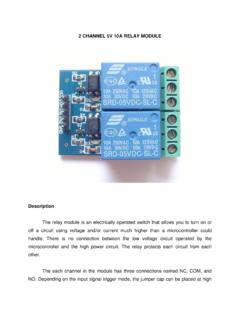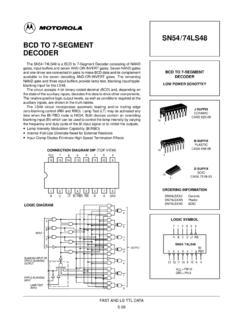Transcription of Arduino Uno R3 - fecegypt.com
1 Arduino Uno R3. INTRODUCTION. Arduino is used for building different types of electronic circuits easily using of both a physical programmable circuit board usually microcontroller and piece of code running on computer with USB connection between the computer and Arduino . Programming language used in Arduino is just a simplified version of C++ that can easily replace thousands of wires with words. Arduino UNO-R3 PHYSICAL COMPONENTS. ATMEGA328P-PU microcontroller The most important element in Arduino Uno R3 is ATMEGA328P-PU is an 8-bit Microcontroller with flash memory reach to 32k bytes.
2 It's features as follow: High Performance, Low Power AVR. Advanced RISC Architecture o 131 Powerful Instructions Most Single Clock Cycle Execution o 32 x 8 General Purpose Working Registers o Up to 20 MIPS Throughput at 20 MHz o On-chip 2-cycle Multiplier High Endurance Non-volatile Memory Segments o 4/8/16/32K Bytes of In-System Self-Programmable Flash program memory o 256/512/512/1K Bytes EEPROM. o 512/1K/1K/2K Bytes Internal SRAM. o Write/Erase Cycles: 10,000 Flash/100,000 EEPROM. o Data retention: 20 years at 85 C/100 years at 25 C.
3 O Optional Boot Code Section with Independent Lock Bits o In-System Programming by On-chip Boot Program o True Read-While-Write Operation o Programming Lock for Software Security Peripheral Features o Two 8-bit Timer/Counters with Separate Prescaler and Compare Mode o One 16-bit Timer/Counter with Separate Prescaler, Compare Mode, and Capture Mode o Real Time Counter with Separate Oscillator o Six PWM Channels o 8-channel 10-bit ADC in TQFP and QFN/MLF package o Temperature Measurement o 6-channel 10-bit ADC in PDIP Package o Temperature Measurement o Programmable Serial USART.
4 O Master/Slave SPI Serial Interface o Byte-oriented 2-wire Serial Interface (Philips I2 C compatible). o Programmable Watchdog Timer with Separate On-chip Oscillator o On-chip Analog Comparator o Interrupt and Wake-up on Pin Change Special Microcontroller Features o Power-on Reset and Programmable Brown-out Detection o Internal Calibrated Oscillator o External and Internal Interrupt Sources o Six Sleep Modes: Idle, ADC Noise Reduction, Power-save, Power-down, Standby, and Extended Standby I/O and Packages o 23 Programmable I/O Lines o 28-pin PDIP, 32-lead TQFP, 28-pad QFN/MLF and 32-pad QFN/MLF.
5 Operating Voltage: o - Temperature Range: o -40 C to 85 C. Speed Grade: o 0 - 4 - , 0 - 10 - , 0 - 20 MHz @ - Power Consumption at 1 MHz, , 25 C. o Active Mode: mA. o Power-down Mode: A. o Power-save Mode: A (Including 32 kHz RTC). Pin configuration ATMEGA16u2- mu microcontroller Is a 8-bit microcontroller used as USB driver in Arduino uno R3 it's features as follow: High Performance, Low Power AVR. Advanced RISC Architecture o 125 Powerful Instructions Most Single Clock Cycle Execution o 32 x 8 General Purpose Working Registers o Fully Static Operation o Up to 16 MIPS Throughput at 16 MHz Non-volatile Program and Data Memories o 8K/16K/32K Bytes of In-System Self-Programmable Flash o 512/512/1024 EEPROM.
6 O 512/512/1024 Internal SRAM. o Write/Erase Cycles: 10,000 Flash/ 100,000 EEPROM. o Data retention: 20 years at 85 C/ 100 years at 25 C. o Optional Boot Code Section with Independent Lock Bits o In-System Programming by on-chip Boot Program hardware-activated after reset o Programming Lock for Software Security USB Full-speed Device Module with Interrupt on Transfer Completion o Complies fully with Universal Serial Bus Specification REV o 48 MHz PLL for Full-speed Bus Operation: data transfer rates at 12 Mbit/s o Fully independent 176 bytes USB DPRAM for endpoint memory allocation o Endpoint 0 for Control Transfers.
7 From 8 up to 64-bytes o 4 Programmable Endpoints: IN or Out Directions Bulk, Interrupt and Isochronous Transfers Programmable maximum packet size from 8 to 64 bytes Programmable single or double buffer o Suspend/Resume Interrupts o Microcontroller reset on USB Bus Reset without detach o USB Bus Disconnection on Microcontroller Request Peripheral Features o One 8-bit Timer/Counters with Separate Prescaler and Compare Mode (two 8-bit PWM. channels). o One 16-bit Timer/Counter with Separate Prescaler, Compare and Capture Mode(three 8- bit PWM channels).
8 O USART with SPI master only mode and hardware flow control (RTS/CTS). o Master/Slave SPI Serial Interface o Programmable Watchdog Timer with Separate On-chip Oscillator o On-chip Analog Comparator o Interrupt and Wake-up on Pin Change On Chip Debug Interface (debug WIRE). Special Microcontroller Features o Power-On Reset and Programmable Brown-out Detection o Internal Calibrated Oscillator o External and Internal Interrupt Sources o Five Sleep Modes: Idle, Power-save, Power-down, Standby, and Extended Standby I/O and Packages o 22 Programmable I/O Lines o QFN32 (5x5mm) / TQFP32 packages Operating Voltages o - Operating temperature o Industrial (-40 C to +85 C).
9 Maximum Frequency o 8 MHz at - Industrial range o 16 MHz at - Industrial range Pin configuration OTHER Arduino UNO R3 PARTS. Input and Output Each of the 14 digital pins on the Uno can be used as an input or output, using pinMode (), digitalWrite(), and digitalRead() functions. They operate at 5 volts. Each pin can provide or receive a maximum of 40 mA and has an internal pull-up resistor (disconnected by default) of 20-50 k Ohms. In addition, some pins have specialized functions: o Serial: 0 (RX) and 1 (TX). Used to receive (RX) and transmit (TX) TTL serial data.
10 These pins are connected to the corresponding pins of the ATmega8U2 USB-to-TTL Serial chip. o External Interrupts: 2 and 3. These pins can be configured to trigger an interrupt on a low value, a rising or falling edge, or a change in value. o PWM: 3, 5, 6, 9, 10, and 11. Provide 8-bit PWM output with the analogWrite() function. o SPI: 10 (SS), 11 (MOSI), 12 (MISO), 13 (SCK). These pins support SPI communication using the SPI library. o LED: 13. There is a built-in LED connected to digital pin 13. When the pin is HIGH value, the LED is on, when the pin is LOW, it's off.








